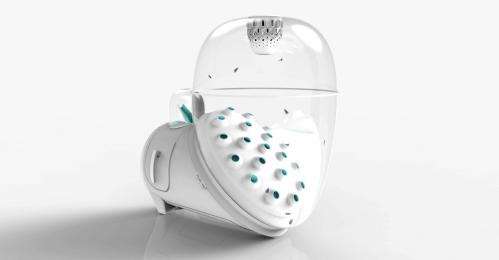July 29, 2013 weblog
Insect larvae turn pan-ready with home appliance Farm 432

Scientists concerned about world hunger, dwindling resources and wasteful processes are looking more closely into alternative prospects for protein, and edible insects are of considerable interest. An Austrian industrial designer, Katharina Unger, who "rethinks systems and design strategies," and studied at the University of Applied Arts Vienna, has proposed a way to harvest and eat insects via a domestic harvesting machine.
"By 2050 meat production will have to increase by 50 percent. Considering that we already use one third of croplands for the production of animal feed, we will have to look for alternative food sources and alternative ways of growing it," she said. Her suggestion for alternatives is in the form of a domestic appliance that can make protein food out of black soldier flies.
This is a tabletop insect farm for harvesting and preparing food for meals. "Insects are healthy, nutritious alternatives to mainstream staples such as chicken, pork, beef and even fish [from ocean catch]," says a recent United Nations Food and Agriculture Organization (FAO) report."Many insects are rich in protein and good fats and high in calcium, iron and zinc."
Unger's home-maker appliance is called Farm 432. She designed it to counter the "dysfunctional system of meat production," instead growing a source of protein at home.
To start, one would take black soldier fly larvae, drop them into an appliance chamber, where they would grow and then move to a larger chamber, mate, produce larvae, the latter falling down into a kindergarten area, mature, move on up a tube, and fall into a cup. The cook removes them from the cup and cooks them for eating. A few of the larvae are dropped back into the top of the machine to restart the cycle.
Unger said, "After 432 hours, 1 gram of black soldier fly eggs turn into 2.4 kilogram of larvae protein, larvae that self-harvest and fall clean and ready to eat into a harvest bucket." She also pointed out that the larvae can be fed on bio waste, and the production almost costs no water or CO2. In nutritional value, "Black soldier fly larvae are one of the most efficient protein converters in insects, containing up to 42 percent of protein, a lot of calcium, and amino acids."
Unger had first worked on fly larvae for food using a prototype system. She ordered the larvae and built her fly colony as an experiment to ensure the process could work. She then scaled the system to perform the same process on a machine for home use.
Farm 432 is a concept that, in theory, might take a few really brilliant marketers and creatives to convince a large segment of Americans and Europeans that insects are good to eat. Certainly, however, eating insects would not be a difficult adjustment for many. Two billion people do eat insects, from ants to beetle larvae, according to the FAO report, largely in Asia, Africa and Latin America. Crispy-fried locusts and beetles are eaten in Thailand,
As for taste, it has become commonplace for testers to use "like chicken" to describe their first experiences with strange foods. As for Unger, in describing the larvae, she said, ."When you cook them, they smell a bit like cooked potatoes."
More information: www.kunger.at/161540/1591397/o … -432-insect-breeding
© 2013 Phys.org



















